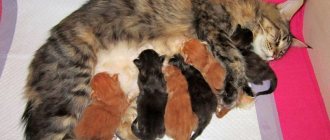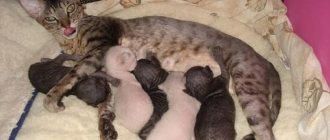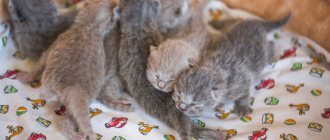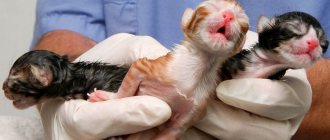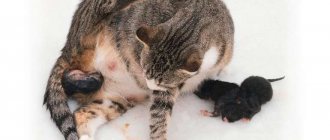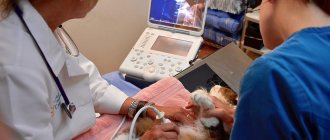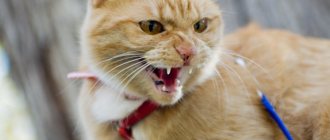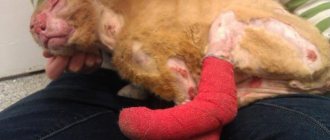Reproduction is no less important a natural process in the life of animals than, for example, nutrition or growth. While protecting the health of their beloved pet, owners often face the problem of continuing the cat family. At the same time, when the animal is about to give birth, the whole family panics, because what to do if the cat needs help?
At what age do cats give birth?
From 7 months, the cat begins to be interested in the opposite sex and becomes sexually mature. If you want to get healthy offspring, veterinarians advise breeding the animal during its second heat.
Cats can give birth until old age, but pet owners should stop their pet’s sex life in time so that the quality of the offspring and the health of the cat are not affected. After all, when abusing a cat’s ability to give birth, people often think only about their own wallet. Thus, to avoid problems, veterinarians recommend spaying or neutering an animal at the age of 6-7 years.
How to tell if your cat is pregnant
Signs of pregnancy in a cat can be observed 3 weeks after conception. Some people who let their cats go outside can track this period on a calendar (as a rule, the cat does not spend the night at home and does not appear in front of its owners for 3-4 days). Those owners who specifically breed a cat with a cat can also calculate whether the cat is pregnant. We will tell you further how many months you will have to wait for a replenishment. The most difficult thing to predict pregnancy is for those owners whose cat walks outside on its own.
You can determine that a cat is pregnant by the following signs:
- the cat’s appetite has changed: it happens that favorite treats remain untouched, and any food consumption ends in vomiting and severe weakness;
- changes in behavior: the cat sleeps more than before and moves less (if the cat was previously wild and could bite, now it should be affectionate and calm);
- swelling of the mammary glands and redness of the nipples;
- rounding of the abdomen.
Changes in cat behavior
At the beginning of pregnancy, it is almost impossible to recognize the interesting position of the cat. The appetite changes: the animal begins to eat a little more or a little less. Also, the animal's sleep time increases. Experts note that cats are characterized by excessive affection and a reverent attitude towards their owner. They are more willing to let themselves be petted. This is a manifestation of simultaneous motherhood and character change.
A female cat may suddenly develop an appetite and persistently ask for food from her owner. And it’s better not to make her nervous and hungry. During pregnancy, the belly grows, the animal begins to show increased attention to its hygiene, licking itself more often. Also, behavior is characterized by caution and restlessness. If the cat has been walking outside, then during pregnancy she will limit herself to such walks.
When approaching before giving birth, she begins to purr pitifully, licks the household, as if showing care: from the owners and close guests to other animals in the house. This is a manifestation of maternal instinct. A pregnant cat screams during childbirth and when contractions occur.
Cat pregnancy
Pregnancy in a cat lasts 65-70 days (9-10 weeks, or 2.5 months). If you are unable to independently determine whether pregnancy has occurred and how many months the cat will still bear kittens, seek advice from a specialist.
In the last week before giving birth, the cat begins to choose a place for itself and put its “stuff” there. Owners are advised to think about creating favorable conditions for the animal from the very beginning of pregnancy: choose a spacious box, put diapers or cloth rags on the bottom. The expectant mother should get used to the nest that you built for her.
The duration of pregnancy in cats may vary depending on the number of kittens, the age of the animal and the conditions in which the pet is in the last month of pregnancy. So, if the cat is stressed, then the gestation period may be delayed, and if the pregnancy is multiple, then labor may begin prematurely, in this regard, it is extremely important to know how to understand that a cat is beginning to give birth.
If the due date is postponed a week earlier or a week later, you should not panic, as this is quite natural.
Problems may arise if labor begins earlier than 60 days (the kitten will be born weak and unable to live) or later than 80 days (there is a possibility that the offspring will develop pathologies).
Signs of the beginning of labor in a cat can be determined a day before, or even 1-2 hours before the start of the process.
Stages and timing of normal pregnancy
Cats become ready for pregnancy after six months of age. The optimal age is 6-9 months after birth. In different breeds, the process of growing up occurs differently and depends on the weight and size of the animal, conditions of detention and development.
Pregnant cat
The optimal pregnancy period is from 63 to 72 days. True, if there are 5-8 kittens, then birth may occur at 58-62 days and this will be normal. In other words, the gestational age is 2 months or 9 weeks.
As a rule, owners of purebred animals themselves organize the mating and know when the animal could become pregnant and they themselves begin to count the approximate period. After 2.5 weeks, the cat’s nipples become coral in color, and the belly begins to grow. You can conduct an ultrasound and find out the number of kittens after 15 days of pregnancy, and the enlargement of the abdomen also occurs due to increased appetite. The most accurate information can be obtained after the 40th day of pregnancy.
The fetuses in the belly begin to take on a cat-like appearance around mid-term. Ultrasound is considered the safest method of fetal counting, since careless and frequent palpations can harm the fetuses.
The final stage begins after 7 weeks, the animal becomes almost “round”, the female begins to behave strangely, the appetite is already decreasing, the animal sleeps a lot. A few days before lambing, the female becomes as restless as possible, her temperature drops and the nesting instinct manifests itself. White discharge begins from the uterus. Giving birth to a cat is much easier than to giving birth to a human. Everything happens naturally; there is no need to contact a veterinarian.
Animal ultrasound
How many days before birth does milk appear?
Females produce milk to feed the future brood shortly before lambing. As a rule, this is 2-3 days. In some cases, this happened 8 days before the kittens were born. White discharge appears on the nipples, the nipples themselves swell and become more noticeable. Sometimes milk may appear late if the female is primiparous or very nervous. True, the first appearances can hardly be called milk; its composition and density are not the same as milk. This is called colostrum.
After lambing or 3-4 days after the appearance of colostrum, the cat produces normal milk, which the kittens will feed on. You need to pay attention to the behavior of kittens. If the kittens sleep well and behave calmly, there is enough milk. But if your sleep is poor and restless, most likely there is not enough milk. The reason for the lack of milk can be health problems, nerves and poor nutrition of the mother. To prevent kittens from going hungry, they can be “supplemented” with special mixtures from pet stores or warm cow’s milk using a pipette or pacifier. If childbirth has occurred, but colostrum has not appeared, you should purchase formula for the first time so that the kittens do not remain hungry. If milk does not appear over time, the animal should be shown to a veterinarian.
Stages of pregnancy
Cat pregnancy is usually divided into several stages:
- Stage 1 – the first three weeks of pregnancy. The mammary glands and genitals become swollen, cats begin to sleep more, there is no appetite as such, and activity is zero. The animal requires attention, sleeps with the owner, clinging to him, the animal may have a gag reflex when eating, or an increase in the size of the uterus upon palpation.
- Stage 2 – from the fourth to the sixth week. The kittens begin to become active and move. The expectant mother has a good appetite and gets plenty of rest. A cat may refuse its favorite food and prefer dairy products. If your cat is vomiting, it is best to take it to the vet.
- Stage 3 – six to nine weeks. Kittens move actively, this is best noticeable when the animal is sleeping. The abdomen is large, the mammary glands are enlarged, colostrum may be released. Hair falls out on the cat's belly, internal organs are displaced due to the large size of the kittens. The cat moves carefully, tries not to jump too much, and sleeps on its side. To prevent the pet from gaining excess weight, it is transferred to fractional meals (4-5 times a day).
How does the stomach change during pregnancy?
20 days after conception, the nipples change color. If you have already given birth before, your nipples may change slightly. The belly grows as the kittens grow and develop. But if 1-2 kittens develop and grow in the mother’s belly, then the belly may be small until the last weeks.
Before giving birth, a cat's stomach drops. As a rule, this happens within 7 days, and the stomach takes a pear shape. This is due to the fact that the kittens are already preparing for birth, taking the necessary position for this.
It should also be noted that the expectant mother’s stomach is not soft, but hard, which means that the body is ready for labor and childbirth.
We look at physiological symptoms
As the birth process approaches, it's time to pay attention to some physiological changes.
Belly shape
You can also determine the imminent onset of labor by looking at your pet’s belly. Watch her when she sleeps: kittens are often already actively moving in their stomachs, taking a comfortable position before they are born. This happens about two days before lambing, especially if your cat has large babies. This is why you may notice how the expectant mother's stomach drops.
Nipple enlargement
A harbinger of an imminent birth is also swollen nipples in a cat. As a rule, immediately before lambing she no longer leaves her shelter. At the same time, the nipples on her stomach noticeably enlarge and turn red. You may also notice some discharge appearing. This is colostrum, which is released just before birth.
Temperature change
First of all, you need to find out how the cat behaves before the imminent start of lambing. However, physiological signs also need to be paid attention to. They indicate the immediate onset of contractions, which means you can complete all the important preparations and take time to be near your pet at this difficult moment for her.
For example, the cat’s rectal temperature decreases significantly and is about 36 °C, which is, in principle, normal. That is why many experts recommend that cat owners measure their pet’s temperature twice a day a few days before lambing. As soon as it has decreased, this will be a clear signal for the start of labor.
Mucus discharge
When a cat is about to give birth, she begins to have active mucous discharge from the vagina. At the same time, she tries to lick them off. At the level of instincts, the cat understands that maintaining cleanliness is very important, otherwise the kittens may be infected when born. In addition to the fact that your pet actively licks its genitals before the onset of labor, you can also notice their significant swelling and redness. This is another key sign that every cat owner should pay attention to.
Leakage of amniotic fluid
After the cat’s mucous plug, which has a characteristic yellowish or pink tint, comes out, yellow discharge (amniotic fluid) appears. This means that contractions are about to begin.
Be sure to stay close to your furry pet, as she needs your support, especially if you are dealing with a firstborn.
Understanding how to determine the symptoms of the onset of labor in a pregnant cat is imperative. Every cat owner wants not only to learn how to care for their pet, but also to get healthy and strong babies. A description of the basic signs of the onset of labor is no less important knowledge than the skills of mating or caring for a cat throughout pregnancy. Be sure to learn and remember the main behavioral points, as well as physiological symptoms.
What to prepare before giving birth to a cat
For comfortable bearing of kittens and their comfortable maintenance in the first weeks after birth, the cat should create all the conditions and prepare a cozy nest. It is best to place this place in silence, away from a noisy room and children, otherwise the cat will look for another place for itself and the kittens.
It is also necessary to organize a spacious maternity area in which the mother and kittens will stay for about two months.
How to care for a cat after giving birth
Childbirth and the postpartum period are not an easy process, both for the new mother herself and for her owner. With the arrival of kittens in the house, additional worries arise in caring for the babies and the parent herself.
How to properly care for a cat after giving birth:
- Upon completion of labor, give the cat water, she urgently needs to restore the water balance in the body. A nursing mother cat should always have free access to water.
- Give her a complete and balanced diet. A cat needs good nutrition, which will determine the quality and volume of milk produced. Place a bowl of food and water close to the box with the offspring.
- You also need to place a tray nearby so that the young mother can safely go to the toilet without leaving her babies for a long time. Keep the tray clean and hygienic, change the filler promptly and clean the toilet from any dirt.
- In the first weeks after giving birth, it is better not to let the mother cat go outside, where there are always many dangerous infections that pose a potential threat to the lives of newborn kittens.
- Within 1-2 weeks after birth, heavy discharge is observed from the cat’s genitals. As a rule, she licks them off on her own and monitors the hygiene of her genitals. However, some cats who have undergone difficult births and have weakened immune systems cannot cope with such care. The owner can wipe the animal's reproductive organs using a clean, damp towel or napkin.
- In the box where the cat and her offspring are kept, it is recommended to change the diaper daily to maintain hygiene.
Watch the mother cat and her offspring. If pathological signs are detected, call your veterinarian! A good doctor will make a home visit and examine the mother and kittens, after which she will give useful recommendations and all the necessary appointments.
We hope that your pet’s birth will go as quickly and without complications as possible, and that the newborn kittens will have strong immunity and excellent health!
What is not recommended to do before labor begins
To ensure a smooth birth, pay attention to the list of things you should not do:
- irritate the woman in labor with loud screams, numerous guests, parties;
- actively feel the stomach, as you may accidentally injure the cat or kittens;
- Give your cat medications on your own without consulting a specialist;
- ignore vomiting, discharge and changes in the behavior of the pregnant woman;
- allow your cat to come into contact with animals whose health status you do not know;
- allowing you to sleep in a dirty place, handling the animal with dirty hands, frequently changing the linen in the cat’s sleeping area;
- use chemicals to clean the house.
What to feed a pregnant cat
A cat preparing for the birth of offspring should be fed high-calorie food enriched with vitamins and minerals.
In the first two weeks of pregnancy, the cat's appetite will increase, so the amount of food should be increased by 10%. The animal must be fed 4 times a day in small portions.
From the 3rd week of pregnancy, the cat's appetite is maximum. It is necessary to increase the volume of food by 50%, but in no case should she be allowed to overeat; she should be fed 5-6 times a day in fractional portions.
A cat's diet should include:
- meat (chicken, beef, turkey);
- egg yolk;
- vegetables (carrots, cabbage);
- dairy products (kefir, cottage cheese, yogurt, sour cream);
- cereals and cereals (buckwheat, rice, wheat);
- a small amount of fish.
If you feed your pet dry food, then choose food for pregnant cats, and then for nursing mothers.
To increase your cat's lactation, give her fresh nettle, but first pour boiling water over the herb so as not to burn the cat's internal organs and mouth.
Characteristic signs before childbirth
It is extremely important to know what signs to look out for before your cat gives birth:
- The animal loses its appetite: the cat refuses solid food and eats small amounts of liquid foods (broth, milk, cream, etc.).
- Weakness: The cat spends almost all of her time in the place where she plans to give birth.
- Kittens in the stomach begin to become active: this happens 2 days before birth, as they try to take the correct position for birth. The more kittens there are, the larger they are, the earlier they begin to move and behave more actively.
- The cat often licks its genitals.
- The animal's body temperature decreases, which helps prevent severe bleeding during and after childbirth.
- The nipples swell and milk comes out.
- When labor begins, the cat meows and tries to hide.
- False contractions begin 4-6 hours before birth.
- The waters are receding. This is the main sign of the beginning of labor in a cat. Don't go far, your pet may need your help.
- The cat's plug came out. When will labor begin? A day before giving birth, a white plug comes out as a discharge. The cat may lick it, so watch the animal carefully so as not to miss this moment.
- The cat goes to the toilet often.
- The pet begins to walk with shortness of breath and breathes heavily in its sleep.
Cat before birth
So, as we have already said, the first signs of impending labor are observed 7-10 days before
From this period, the owner should pay special attention to his cat. If she goes for a walk outside the house, take her from the street and try not to leave her alone for a long time
You can tell that a cat is ready to give birth by the following signs:
- often lie down in a prepared box on your back;
- in the stomach you can visually notice the active movement of kittens;
- the cat begins to actively wash itself, lick the genitals, even to the point of licking off all the fur under the tail;
- a day before giving birth, she is constantly in the birth box, from where she comes out to drink water or milk;
- does not eat anything on the last day before giving birth;
- The animal's genitals become noticeably swollen, and redness of the nipples and skin under the tail is also observed.
Have you noticed these signs in your cat? Then you no longer have to wonder how long it will take for her to give birth. Here everything is already extremely clear - childbirth can take place at any minute within the next 24 hours! Be prepared for this process and purchase everything you need in advance in case complications arise during labor.
How can you tell if your cat has started giving birth? Before giving birth, a mucus plug comes out of the cat’s genitals, then the birth process begins, during which the cat can meow loudly and pitifully. At this moment, the owner should be nearby and calm his pet with gentle stroking and kind words of support.
To make it easier for you to navigate this difficult matter, consult in advance with a veterinarian who will answer all your questions in detail. Childbirth can happen differently for each animal.
For example, ordinary cats that do not have pedigree roots often give birth on their own. The owner may not even notice this process and see already born kittens affectionately eating their mother's milk.
It is impossible to predict how the birth will go. This depends on the individuality of the animal’s body and whether the cat has given birth before. Young individuals bearing offspring for the first time take longer than usual to give birth and often scream loudly. Due to lack of experience, such cats often try to run out of the box, which is not at all recommended.
It is also not advisable to allow rollovers and squats. In such positions, a cat can seriously harm her kittens. To eliminate such risks, the owner needs to control the birth process and prevent such positions of the animal’s body. It is better to carefully turn her on her side and gently stroke her stomach and back. This will calm the frightened mother cat a little.
Even an inexperienced owner will notice that the cat has begun to give birth. The first kitten will emerge from the genitals of the expectant mother. At this moment, the woman in labor will strain and push very hard, thereby trying to quickly push the baby to the light.
The first kitten may be in the amniotic sac, which occurs if it does not burst during birth. The cat will be able to free the baby from the bubble by carefully gnawing the shell.
If this does not happen, take the initiative and free the newborn from the bladder using sterile scissors. When cutting the shell, be extremely careful and attentive so as not to harm the kitten.
How can you tell if your cat is no longer giving birth? The frequency of birth of each kitten is 15-40 minutes. This means that you won’t have to expect a quick birth. After the kitten is born, the placenta emerges from the genitals, which she must eat. This will allow the woman in labor to quickly realize motherhood and speed up the lactation process.
As a rule, the owner does not have to persuade the cat; it eats the placenta by force of natural instinct.
After the placenta is delivered, you can understand that she gave birth to all the kittens and has already finished giving birth. It is very good if the birth was successful for both the mother cat and her offspring. But sometimes complications occur, which we will now talk about!
How to tell if your cat is going into labor
Throughout pregnancy, the cat behaves in the same way as all animals of its species: it eats excellently and sleeps a lot.
Usually, the question “how to understand that a cat is going into labor” does not arise for owners, since everything becomes obvious from the changing behavior of the animal. When the day of birth arrives, the cat shows the first signs that signal the animal’s readiness to give birth - a symptom of the first contractions: the cat screams unnaturally, refuses to eat, walks from corner to corner, looks into the owner’s eyes. The cat looks tired, constantly licks its genitals, and “points” to its stomach, as if it wants to say that it needs help.
Signs of approaching labor
To understand that a cat is about to give birth, you need to carefully observe how she behaves and monitor the signs of an approaching event.
About 2 weeks before giving birth, the pet begins to look for a secluded place for itself and its future offspring. It is better for the owner to prepare and show the expectant mother a cozy nest in which she will feel safe.
Important! The owner needs to be prepared for the fact that the individual may begin to give birth where it overtakes it. This is especially true for first-time mothers.
Pregnant cat
A few days before delivery:
- the cat changes its behavior: it becomes restless, meows loudly, can be aggressive or, on the contrary, very affectionate;
- Her body temperature drops to 37 degrees.
- she actively licks her stomach and genitals;
- colostrum begins to be released from the breast, the nipples swell and turn red;
- the pet refuses to eat, only drinks and becomes inactive;
- There is movement of the babies in the womb.
Childbirth
How does labor begin in a cat?
- The cat lies on its side.
- Begins to arch his back.
- Push (strain your stomach). If you put your palm on your stomach, you can feel it.
- Meows loudly as the strength of the contractions increases.
- Passage through the genital tract: the cat strains, the muscles of the abdomen and thighs contract. After 4-5 attempts, the kitten appears.
- The kitten comes out in the amniotic sac or without a sac.
- Stimulation of breathing: the cat bursts the bladder, licks the kitten, and clears the airways of fluid.
- Rupture of the umbilical cord. The cat chews the umbilical cord and eats the afterbirth. Be sure to check that there are as many afterbirths as there are kittens.
- Lactation: Immediately after birth, the kitten attaches itself to the mother's nipple.
What to do when a cat gives birth?
Most cats give birth to kittens on their own without the help of their owners. However, sometimes the owner still has to give birth to a pet, since his inaction can lead to adverse consequences. The owner should help the animal during labor in the following cases:
- the baby’s head has not appeared after 4-5 strong attempts - lubricate the rounded edge of the pipette with Vaseline , insert it into the vagina, expand it, trying to see where the fetus is and at the same time stroke the mother’s belly in the direction of expulsion;
- the baby was born in a pouch , and the cat does not pay attention to it - open the bubble with scissors, remove mucus from the nose and mouth;
- the baby is not breathing - rub it with a towel in the back and chest for 3-4 minutes. If this does not help, then take the kitten by the legs and shake it upside down, tap its chest, and clear the airways. However, when the next baby appears, resuscitation measures must be stopped, the non-breathing one should be wrapped in a towel and placed under a lamp. Only after making sure that the newborn is in normal condition can you return to resuscitation of the previous kitten.
Newborn kittens
Helping a cat give birth
The animal needs care and support at the time of birth. Therefore, the owner is required to:
- calm your pet throughout the entire process;
- sit near the place where the cat will give birth;
- bring a supply of water so that the cat does not walk around the room again, because she will want to drink in any case (it is necessary to regularly offer the animal to drink warm milk or water at room temperature to avoid dehydration);
- isolating the room where the lambing takes place from other pets and children; it is best to remain alone with the woman in labor - this will make both her and you feel calmer;
- do not forget to ventilate the premises, but without creating a draft;
- Call the veterinarian if complications arise or there are fears that something will go wrong, or if you are not confident in your abilities and are afraid that you will not be able to help your pet
It is impossible to ignore the first signs of labor in a cat, despite the strong opinion that a cat can give birth without any problems without human help.
Signs of labor in a cat
It is very important for the owner to notice the signs of childbirth in a timely manner for the owner, because this is what makes it possible to accurately determine the duration of the birth process and, if necessary, provide assistance to the pet. If you miss the start of lambing, it may be difficult to determine whether intervention is necessary. If the animal’s condition is good and the process is going correctly, then intervention is not required. When the birth of kittens is delayed, a veterinarian is necessary. After examining the four-legged woman in labor, he will determine the need for one or another assistance.
Complications during childbirth are more often observed in purebred animals and too young females, whose body has not yet fully formed. Outdoor cats, which have the opportunity to constantly be in the fresh air and spend time actively, rarely encounter problems during pregnancy and lambing due to the fact that their bodies are strong and well-trained. He can easily bear the load and easily prepares himself for the birth of kittens without any intervention. However, signs of impending birth in a cat that lives at home should alert their owners. If there is a week left before the birth of the offspring, a female who gives birth not for the first time may have completely absent signs.
How to deliver a cat?
Childbirth in cats can be of three levels of complexity:
- Lungs: the cat does not require much human attention and care; it mostly copes on its own. But the owner must observe and control the process so that the cat does not crush her kitten so that the afterbirth comes out. It takes her less than one hour to give birth to a kitten. The cat's discharge the day after birth should not contain mucus, pus, or blood.
- Moderate: at the birth of kittens, the cat has complications that the owner can help cope with, without the help of veterinarians. Lightly stroking the abdomen from the sides to the uterus may help. If the mother does not want to gnaw the umbilical cord, then it is necessary to cut it using disinfected scissors (a few centimeters should remain to the navel), and then treat the incision site with iodine. If the kitten was born in the amniotic sac and the mother is in no hurry to tear it apart, you need to do this yourself so that the baby does not suffocate. To do this, use clean, disinfected hands to tear the film and wipe the baby dry. If the kitten is not breathing, you need to turn it head down and, holding it with both hands, shake it to remove water from the respiratory tract.
- Severe: in this case, you must call a qualified specialist for help. If the cat cannot lamb for more than 5 hours, you can give a Gamavit injection (0.5 cc), which will intensify contractions. If after an hour the medicine does not work, then an injection of Oxytocin (0.5 cc) should be administered. When doing this, you need to massage the belly towards the uterus. To make sure that your cat can be given this medicine, you should consult your veterinarian. The health of your pet depends on you. If the woman in labor can barely move, then sodium gluconate should be administered. The volume of the drug administered depends on the weight of the cat.
How to calculate due date?
For convenience, the cat owner needs to note the mating date of the cat and count 55 days from it. From this day on, you need to carefully look at the animal and note the slightest changes in its behavior or appearance.
The pregnancy of a domestic cat lasts on average 58 days, but prolongation of pregnancy to 65 days is considered normal. Hairless cats (Canadian and Don Sphynxes, Peterbalds) bear offspring for up to 72 days, and this is also a normal variant. At the same time, representatives of short-haired breeds give birth earlier than long-haired ones.
The more kittens in the uterus, the sooner the birth will occur, so if according to ultrasound results there are more than 5 fetuses, they will probably be born on days 55-57, and if less than three, they will remain in the mother’s womb until 63-65 days.
Professional breeders keep a pregnancy calendar for their pets, noting the start of heat, the dates of the main and control matings, the end of the hunt, the appearance of the first signs of pregnancy, dates and results of veterinary ultrasound.
If the cat is free-range and the mating date is unknown, then you should remember when the pet came into heat, as people say, “went on a spree” or began “begging for a cat.”
Mating usually occurs on the 2-3rd day of hunting. Calculations should be made from this date. By the way, if a cat is not a breeding cat, that is, it is not a member of a club, does not take part in exhibitions and does not have permission to breed, then its offspring are considered outbred and will be difficult to adopt.
It is recommended to castrate such cats in order to avoid exhaustion of the body during childbirth and in order to control the number of outbred and stray animals. Pregnancy is not a contraindication for castration. The animal easily tolerates veterinary surgery even in the last weeks of pregnancy.
Unpleasant consequences after childbirth
Unfortunately, childbirth does not always go smoothly; various unpleasant consequences can occur. So, the first thing you need to pay attention to after childbirth is discharge. Any colored, unpleasant-smelling discharge is a deviation from the norm. If a cat has intense pink discharge, this is a sign of a fungal disease of the genital organs. If they are green, there is a bacterial infection. If the discharge is black-green with a strong unpleasant odor, it means rotting. If they are cloudy yellow or yellow-green, there is purulent inflammation in the womb.
Watery discharge is possible, which may be caused by blood accumulation in the uterus, uterine rupture, or rupture of sutures (during caesarean section).
If after birth the bleeding does not stop for 15 minutes, you should urgently take your pet to the veterinarian and provide qualified assistance.
Another problem after childbirth may be the lack of milk. The reason may be the stress of the mother in labor, so you should create comfort and ensure peace of mind for the mother, feed her well and let her drink milk.
It often happens that after giving birth a cat is left with a hanging belly. The reason may be that there is a dead kitten in the stomach. You need to carefully feel the cat's belly and take the animal to the veterinarian.
After giving birth, it is best to feed a cat with easily digestible food, milk with the addition of fish oil and calcium. Water supplies must be constantly replenished.
Preparing for childbirth
A cat's pregnancy lasts 63-65 days. It happens that labor begins 70 days after conception.
If the expectant mother feels well, eats normally, has no digestive problems, and the kittens in her stomach move as usual, then there is no reason to panic, leave the kitten alone until the 70th day.
What needs to be done to ensure that a cat gives birth at home successfully?
Organize a maternity place
Prepare a strong cardboard box measuring (l/w/h) 50/50/30 cm.
It should have a removable “roof” so that you can help the kittens emerge and then do a little cleaning there.
The box must be placed in a place where there are no drafts or noise.
The owner’s task is to organize a convenient maternity place for the cat, where the mother and kittens will be comfortable and safe.
Some install a heating pad under the bottom of the “nest”, others place an infrared lamp above it - this is not important, it is important that the following temperature regime is maintained in the box:
- first week after birth – 29 C
- second – 26 C
- third – 23 C
- fourth and subsequent – 21 C
It is also necessary to leave a place where there is no heating so that the cat can lie down there if it gets hot.
Take care of the hygiene and safety of the maternity area
You should not place soft and thin fabric on the bottom; blind babies can become entangled and suffocate in its folds.
Let it be several layers of newspapers or clean soft paper. Moreover, before giving birth, a cat, following instinct, will want to rummage around and arrange its “nest.”
Introduce the cat to the birthing area in advance. If she refuses to live in it, give her the opportunity to produce offspring in a place of her choice, and then move the mother and children to prepared conditions
Make sure the box does not have any irritating odors. Otherwise, the cat will simply refuse to give birth and raise babies in it.
The entrance to the box should be located at the cat's chest level, which is approximately 10 cm from the floor.
This way it will be better protected from drafts, and the kittens won’t be able to accidentally crawl out.
Introduce the cat to the box in advance. If she refuses to live in it, give her the opportunity to produce offspring in a place of her choice, and then move the mother and her children to prepared conditions.
Keep everything you need for childbirth at hand, because the process can begin at any time
Gather the necessary “equipment”
- Cotton fabric
- Cotton pads
- Waterproof diapers
- Sharp scissors (wipe them with alcohol before delivery)
- Umbilical cord string
- Hydrogen peroxide and iodine
- Disposable syringes, preferably insulin, and oxytocin
- Small rubber bulb
12-24 hours before labor begins, the cat’s body temperature drops to 37°C, maybe even lower; and after its maximum drop, a day later the cat begins to give birth
British cat giving birth
British cats cannot cope with childbirth on their own, so all responsibility lies on your shoulders. Therefore, it is so important to thoroughly understand the question of how labor begins in a British cat.
If the due date is approaching, you need to carefully monitor when the plug (a white-pink clot) comes out.
During pregnancy, it is better to exclude seafood from your pet’s diet, because they destroy vitamin B, which is necessary for kittens.
As a rule, cats who give birth for the first time may experience complications, so you need to prepare in advance:
- diapers that will need to be changed when dirty;
- antiseptic;
- sterilized scissors;
- sterile disposable gloves;
- cotton pads;
- Vaseline oil;
- syringes for 2 and 5 ml;
- calcium gluconate (to stimulate labor).
What to do if this is the first time?
If an individual gives birth for the first time, problems may arise because she does not understand what is happening to her and this puts her in a state of stress. A young mother may begin to give birth under the sofa in pain, be unable to cope with gnawing the umbilical cord, or be unable to free the newborn baby from the bladder.
Therefore, the owner of the first-born should prepare in advance for this situation: know in theory how you can help the cat during childbirth and collect a mini-first aid kit with everything necessary for obstetric care.
Very often, during the first birth, when pushing begins, the animal sits down and tries to look under its tail to understand what is causing it pain. Any attempt can result in the kitten leaving the birth canal, and if the woman in labor sits at this moment, this will injure the cub.
For a description of other problems that are possible during childbirth and what a person can do to eliminate them, see the previous chapter.
